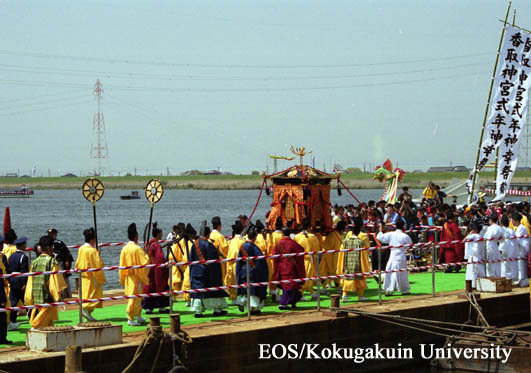- トップ
- Encyclopedia of Shinto
- Shinkōsai
Encyclopedia of Shinto
| Main Menu: | |
| Links: |
詳細表示 (Complete Article)
| カテゴリー1: | 5. Rites and Festivals |
|---|---|
| カテゴリー2: | Individual Shrine Observances |
| Title | Shinkōsai |
| Text | The procession of portable shrines (see the separate entry also titled shinkōsai) is an essential element of nearly all shrine festivals. Here, the festival held May 4 at Toga Shrine in Ichinomiya Town, Hoi District, Aichi Prefecture, will be used as an example, as it brings together various beliefs as the highest-ranked shrine (ichi no miya) in the ancient Mikawa Province (today's eastern Aichi Prefecture). Beginning two days before the festival, people associated with the festival go down to the beach and conduct a purification ritual (misogi harai) using seawater. The ceremony begins at noon on the 4th. The portable shrine (shin'yo) departs when it ends, followed by a large procession consisting of a shishigashira ("lion's head"), taiko (drums), a large sakaki, gakutaiko (drums from the gagaku orchestra), and shōko (a gong used in gagaku), ten court musicians, chests bearing offerings (shinsen), priests (shinshoku), shrine maidens (miko), mounted archers (yabusame), and twelve horses as they all make for the procession's midway resting point (otabisho). A horseback archery contest is held using black bows made from sakaki and arrows made from green bamboo after a ceremony at the resting point. Tremendous numbers of people come this day to worship and receive rice cakes wrapped in bamboo leaves, which are believed to prevent illness. The visitors also purchase windmills, devil masks, and the like to take home as talismans for protection from evil. — Mogi Sakae |





